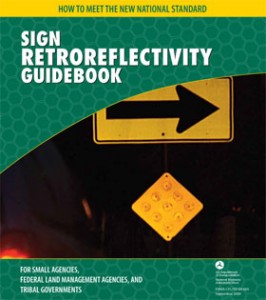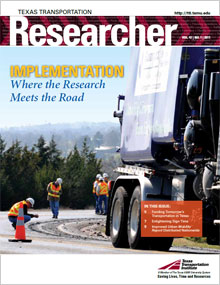
The Federal Highway Administration (FHWA) publishes the Manual on Uniform Traffic Control Devices (MUTCD) establishing national standards for all traffic signs. All agencies that maintain public roadways use the MUTCD to ensure signs and markings are uniform in their design and placement.
Until recently, the MUTCD did not address when a traffic sign should be replaced based on how well it reflects light, also known as its retroreflectivity. Traffic signs use small glass beads or prismatic reflectors to reflect a sign’s information back to the driver’s eyes.
“The retroreflectivity of a sign degrades over time due to natural — and occasionally criminal — causes,” says Paul Carlson, head of Texas Transportation Institute’s Operations and Design Division. “Nighttime fatal crashes occur about three times as often as daytime fatal crashes, so maintaining traffic sign retroreflectivity can be essential to safety.”
The new minimum retroreflectivity requirements in the MUTCD go into effect soon. This change affects thousands of agencies and millions of signs. FHWA has extended compliance dates to ease the transition.
By January 2012, agencies responsible for traffic signs must have a sign maintenance program designed to maintain traffic sign retroreflectivity at or above specific levels. By 2015, agencies must comply with the new requirements for most of their traffic signs, including regulatory, warning and guide signs. By 2018, agencies must comply with the new requirements for overhead guide signs and all street name signs.
Sign maintenance usually occurs at the local level, but not every community has an engineer on staff familiar with retroreflectivity. To aid these agencies, Paul Carlson’s team compiled a toolkit with management resources for keeping track of signs that need to be replaced without having to assess every sign.
“The toolkit gives an overview of what retroreflectivity is, explains compliance and maintenance issues and provides the various forms and letters needed for funding,” says Carlson. “It provides the non-engineer some methods and strategies for maintaining retroreflectivity to the new standard.”
Originally the toolkit was planned as an online resource only. After pilot testing, researchers realized there was also a need for a hardcopy version, so it’s now available through the Local Technical Assistance Program (LTAP). One of their most popular publications, approximately 60,000 copies of the guide have been printed to date.
Private companies also use the toolkit. Joanne Conrad, digital division manager for Traffic and Parking Control Company, travels around the country educating transportation professionals on traffic signs and retroreflectivity. “When we hold tech sessions on how to make a retroreflective sign, I can walk them through the Sign Retroreflectivity Guidebook and show them how to maintain their signs as well,” says Conrad. “I carry copies with me to hand out when I do conferences and tradeshows. It’s a wonderful tool for smaller agencies.”
